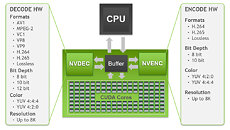ADLINK Puts Intel Arc A-series GPUs on MXM Form Factor
After GUNNIR showed the same product back in January, ADLINK is now offering both Intel Arc A-series GPUs in MXM form factor. The MXM (Mobile PCI Express Module) is a standardized form factor that is used mostly in laptops and some small form factor PCs. Product pages confirm that ADLINK offers both the Intel Arc A370M and the Intel Arc A350M in MXM form factor.
According to specifications The ADLINK MXM-AXe, as the product is called, is MXM 3.1 Type A based on Intel Arc GPU, packing 8 Xe-cores, 128 Execution Units, 4 GB of GDDR6 memory, and TDP of 35-50 W, which is pretty much standard for the Arc A370M GPU. The company also offers the same product with A350M GPU with TDP of 25-35 W. With decent power efficiency, full AV1 hardware encoding, and support for up to four 4K displays, such a GPU would be perfect for small form factor machines, and could be even a decent upgrade for some laptops.
According to specifications The ADLINK MXM-AXe, as the product is called, is MXM 3.1 Type A based on Intel Arc GPU, packing 8 Xe-cores, 128 Execution Units, 4 GB of GDDR6 memory, and TDP of 35-50 W, which is pretty much standard for the Arc A370M GPU. The company also offers the same product with A350M GPU with TDP of 25-35 W. With decent power efficiency, full AV1 hardware encoding, and support for up to four 4K displays, such a GPU would be perfect for small form factor machines, and could be even a decent upgrade for some laptops.



































































